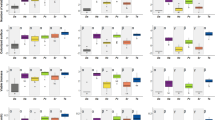Summary
Changes in patterns of microhabitat occupation were examined for six closely related moss species (family Polytrichaceae) found growing together along a complex altitudinal gradient on the northeast face of Mount Washington, New Hampshire. Little evidence could be found to support the hypothesis that the relative distributions of these six moss species were determined by competitive interactions occurring among them. Instead, the data support the hypothesis that changing patterns in the relative distributions of these six moss species result from differences in microhabitat availability among sites. The moss species appear to behave in an opportunistic manner, occupying a wide array of microhabitats as these microhabitats become available to them.
Similar content being viewed by others
References
Apinis A (1939) Data on the ecology of bryophytes. III. The significance of hydrogen-ion concentration on germination of spores and development of some mosses. Horti Bot Lat Viensis 1–22
Bopp M (1963) Development of the protenema and bud formation in mosses. J Linn Soc (Bot) 58:305–309
Bratton SP (1976) Resource division in an understory herb community: responses to temporal and microtopographic gradients. Amer Nat 110:679–693
Brown JH, Lieberman GA (1973) Resource utilization and coexistence of seed-eating rodents in sand dune habitats. Ecology 54:788–797
Cody MD (1978) Distribution ecology of Haplopappus and Chrysothamnus in the Mojave Desert—Niche position and niche shifts on north-facing granitic slopes. Amer J Bot 65:107–1116
Colwell RK, Futuyma DJ (1971) On the measurement of niche breadth and overlap. Ecology 52:567–576
Diamond JM, Marshall AG (1977) Niche shifts in New Hebridean birds. Emu 77:61–72
Forman RTT (1969) Comparison of coverage, biomass, and energy as measures of standing crop of bryophytes in various ecosystems. Bull Torrey Bot Cl 96(5):582–591
Huston M (1979) A general hypothesis of species diversity. Amer Natur 113:81–101
Hutchinson GE (1957) Concluding Remarks. Cold Spring Harb Symp 22:415–427
Hutchinson GE (1978) An Introduction to Population Ecology. Yale Univ Press, New Haven
Inger RF, Colwell RK (1977) Organization of contiguous communities of amphibians and reptiles in Thailand. Ecol Monogr 47:229–253
Lee TD, LaRoi GH (1979) Bryophyte and understory vascular plant beta diversity in relation to moisture and elevation gradients. Vegetatio 40:29–38
Levins R (1968) Evolution in changing environments. Princeton Univ Press: Princeton
Longton RE, Greene SW (1967) The growth and reproduction of Polytrichum alpestre Hoppe on South Georgia. Phil Trans Roy Soc (ser B) 252:295–322
MacArthur RH (1958) Population ecology of some warblers of northeastern coniferous forests. Ecol 39:599–619
May RM (1973) Stability and complexity in model ecosystems. Princeton Monogr in Popul Biol 6
May RM (1975) Some notes on measurements of the competition matrix, α. Ecology 56:737–741
May RM, MacArthur RH (1972) Niche overlap as a function of environmental variability. PNAS 69:1109–1113
Parihar NS (1962) An Introduction to Embryophyta. Vol. I, Bryophyta. Central Book Depot, Allahabad. p 377
Parrish JAD, Bazzaz FA (1976) Underground niche separation in successional plants. Ecology 58:1281–1288
Parrish JAD, Bazzaz FA (1978) Pollination niche separation in a winter annual community. Oecologia 35:133–140
Pianka ER (1973) The structure of lizard communities. Ann Rev Ecol Syst 4:53–74
Pianka ER (1975) Niche relations of desert lizards. In: (ML Cody, JM Diamond (eds)), Ecology and Evolution of Communities Belknap Press
Pianka ER (1976) Competition and niche theory. Chapter 7. In: (RM May (ed)), Theoretical Ecology: principles and applications, Blackwell
Pickett STA, Bazzaz FA (1976) Divergence of two co-occurring successional annuals on a soil moisture gradient. Ecology 57:169–176
Platt NJ, Weis IM (1977) Resource partitioning and competition within a guild of fugitive prairie plants. Amer Natur 111:479–513
Sarafis V (1971) A biological account of Polytrichum commune. New Zeal J Bot 9:711–724
Sarukhán J, Harper JC (1973) Studies on plant demography: Ranunculus repens L., R. bulbosus L. and R. acris. I Population flux and survivorship. J Ecol 61:675–716
Schoener TW (1974) Resource partitioning in ecological communities. Science 185:27–39
Slack NG (1977) Species diversity and community structure in bryophytes: New York State Studies. NYS Museum Bull 428, p 70
Smith GL (1971) A conspectus of the genera of Polytrichaceae. Mem NY Bot Garden 21 (3):1–83
Tramer EJ (1969) Bird species diversity: components of Shannon's formula. Ecology 50:927–929
Vandermeer JH (1972) Niche theory. Ann Rev Ecol Syst 3:107–132
Watson MA (1974) The population biology of six species of closely related bryophytes (Musci) PhD Thesis Yale Univ
Watson MA (1975) Annual periodicity of incremental growth in the moss Palytrichum commune. Bryol 78:414–422
Watson MA (1979) Age structure and mortality in a group of closely related species of mosses. Ecology 60:988–998
Watson MA (1980) Patterns of habitat occupation in mossesrelevance to considerations of the niche. Bull Torrey Bot Cl 107: in press
Watson MA Patterns of microhabitat exploitation of six closely related species of mosses along a complex altitudinal gradient. Ecol (in press)
Watson MA (1981) Chemically mediated interactions among juvenile mosses as possible determinants of their community structure. J Chemic Ecol 7: in press
Werner PA (1976) Ecology of plant populations in successional environments. Syst Bot 1:246–268
Werner PA, Platt WJ (1976) Ecological relationships of co-occurring golden rods. Amer Natur 110:959–971
Whittaker RH (1967) Gradient analysis of vegetation. Biol Rev 42:207–264
Whittaker RH, Levin SA, Root RB (1970) Niche, habitat and ecotype. Am Nat 107:321–338
Author information
Authors and Affiliations
Rights and permissions
About this article
Cite this article
Watson, M.A. Shifts in patterns of microhabitat occupation by six closely related species of mosses along a complex altitudinal gradient. Oecologia 47, 46–55 (1980). https://doi.org/10.1007/BF00541775
Received:
Issue Date:
DOI: https://doi.org/10.1007/BF00541775




